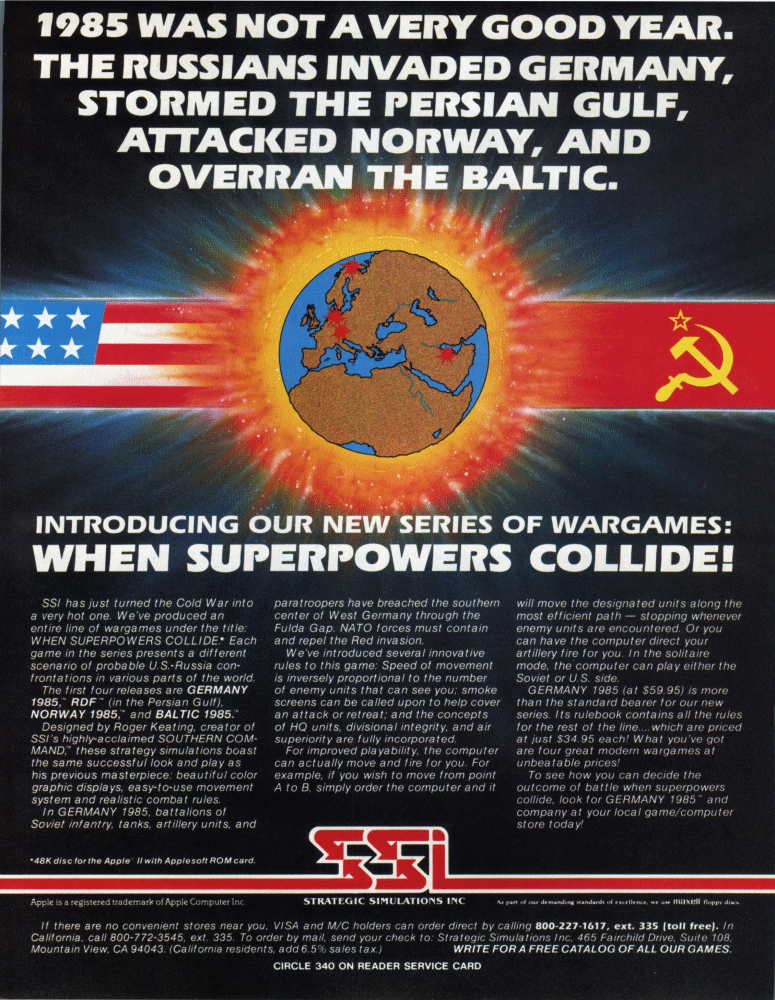This ad seems strangely topical.
History of SSI
Strategic Simulations Inc was founded in 1979 by Joel Billings. Joel’s father, Robert, had served in the US Army during World War II. When he returned home, Robert, developed an interest in wargaming. (Dictionary.com defines war-game as “a simulated military operation”.) He built his own games. According to Antic magazine, “He drilled holes in a piece of wood and drew a map of North Africa on it…He had this elaborate system where he used nails as infantrymen, and carved out little tanks, and used marbles with mirrors and you had to roll the marble down and knock over the opponent's nail.”
Robert passed this interest into Joel. However, Joel quickly discovered that his interest was shared by very few people, especially at school. Also, from the Antic article, “In desperation, he joined the school chess club, taught its members wargames, and started his own wargame club.” Joel also resorted to playing wargames by mail. At one time, he was doing battle with nine opponents.
In college, Joel realized that computers would be used to play wargames. After college, he decided to get into the business of making and selling wargames. He tried to interest a programmer from IBM, but the programmer didn't think that there would be enough interest in the project. Joel decided to put an ad in local hobby shops looking for a programmer who shared his interest in wargames. He discovered two: John Lyon and Ed Willeger.
Around the same time, Joel was introduced to Trip Hawkins, a marketing manager for Apple. Later, Hawkins would go on to found Electronic Arts. Hawkins convinced to make his games for Apple’s computers.
Strategic Simulations’ first game, Computer Bismarck, was released in 1980 and was created by Lyon. This was followed by Computer Ambush which was created by Willeger. Both games were written in BASIC.
In the 15 years that followed, SSI published over 100 titles. In many ways, SSI legitimized wargames and made them available for generations to come.
Looking at the Game
Though it’s not obvious, the above ad is for four games in the “When Superpowers Collide” series from SSI: Germany 1985, RDF (Rapid Deployment Force) 1985, Norway 1985, and Baltic 1985.
The back of Germany 1985’s box said:
IN 1985, RUSSIA INVADED WEST GERMANY. AND THE COLD WAR TURNED RED HOT!
Each game in SSl's new series of modern wargames - WHEN SUPERPOWERS COLLIDE - presents a different scenario of possible U.S.-Soviet confrontations in various tinderboxes around the world. Designed by Roger Keating, creators of SSI’s highly-acclaimed SOUTHERN COMMAND, these simulations boast the same successful look and play as his previous masterpiece: beautiful color graph displays, a sophisticated movement system and realistic combat rules.
GERMANY 1985 leads the way for this great series.
The game cost $59.95 and was available for Apple II’s and Apple II Pluses.
Major Mike Chamberlain wrote the following review for Computer Gaming World’s May-June 1983 issue:
As you hunker down in front of your computer preparing to go toe-to-toe with the Soviet's finest, you begin a scenario which some imagine could occur one day in the Fulda Gap of central Germany. You are in the lead elements of a meeting engagement between NATO and WARSAW Pact Forces in Strategic Simulations' new game, GERMANY 1985; and about the only thing missing is the static on the radio.
Having spent eight years in Germany as an army officer, I was anxious for the opportunity to see and play GERMANY 1985. I haven't been dis- appointed. The game presents, in a reasonable general manner, the challenges (and frustrations) which such a conflict would place on a ground Commander. Allocation of air support, planning air superiority, prioritizing fire support targets, and allocating re-inforcements are just some examples. Add to this a fluid situation and a pow erful opponent (human or computer) and you have the makings of an excellent wargame.
What computer ads would you like to see in the future? Please comment below. If you enjoyed, please share with your friends and relatives. Thank you.







Ads for computer games get a big 👍 from me!
I did some light BASIC programming back in the day, copying code from the back of a 3-2-1 Contact magazine.